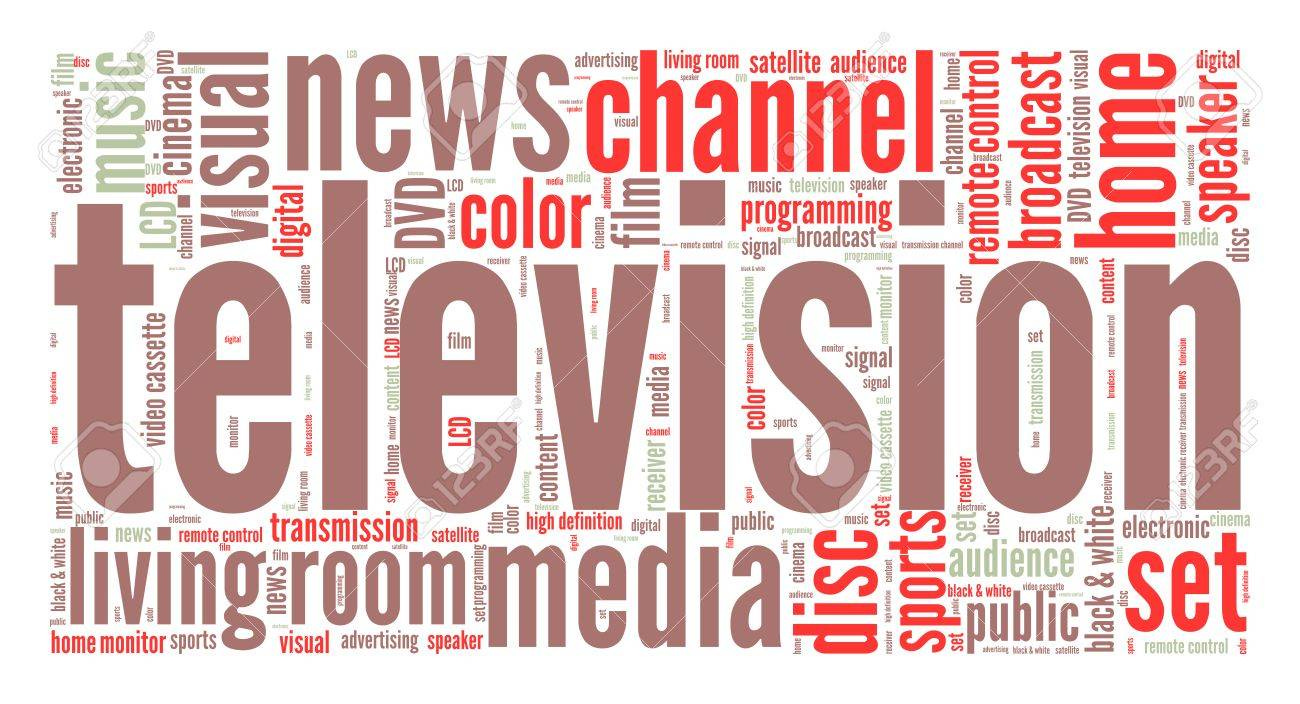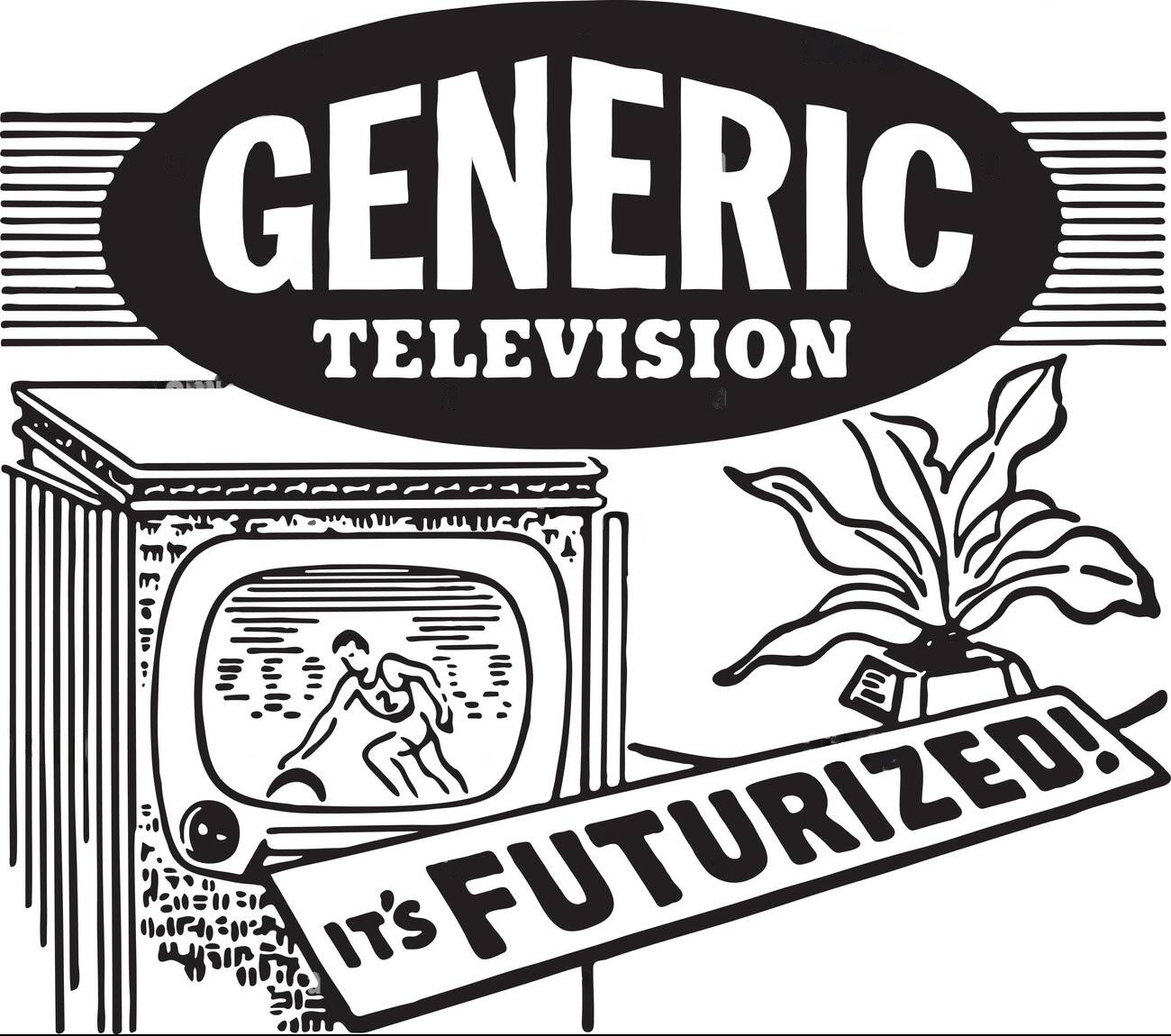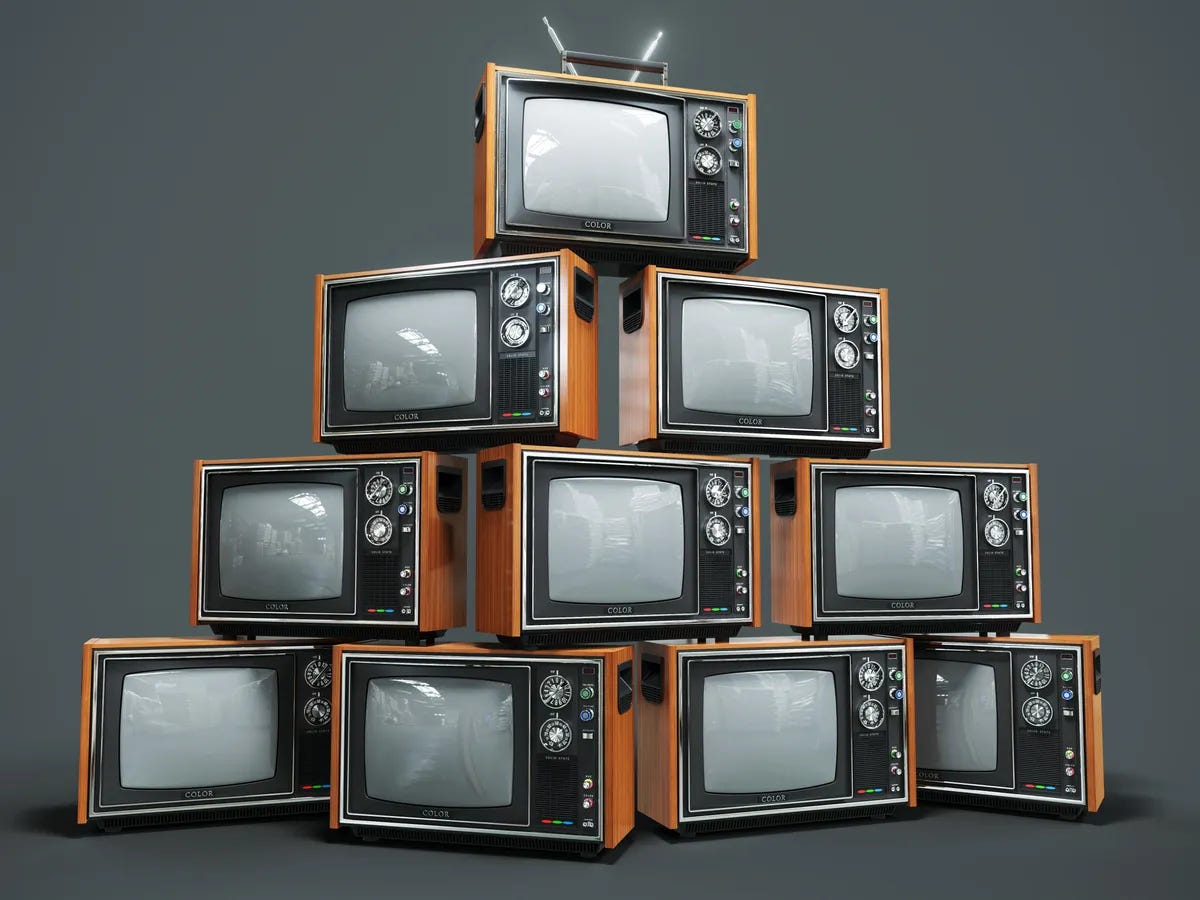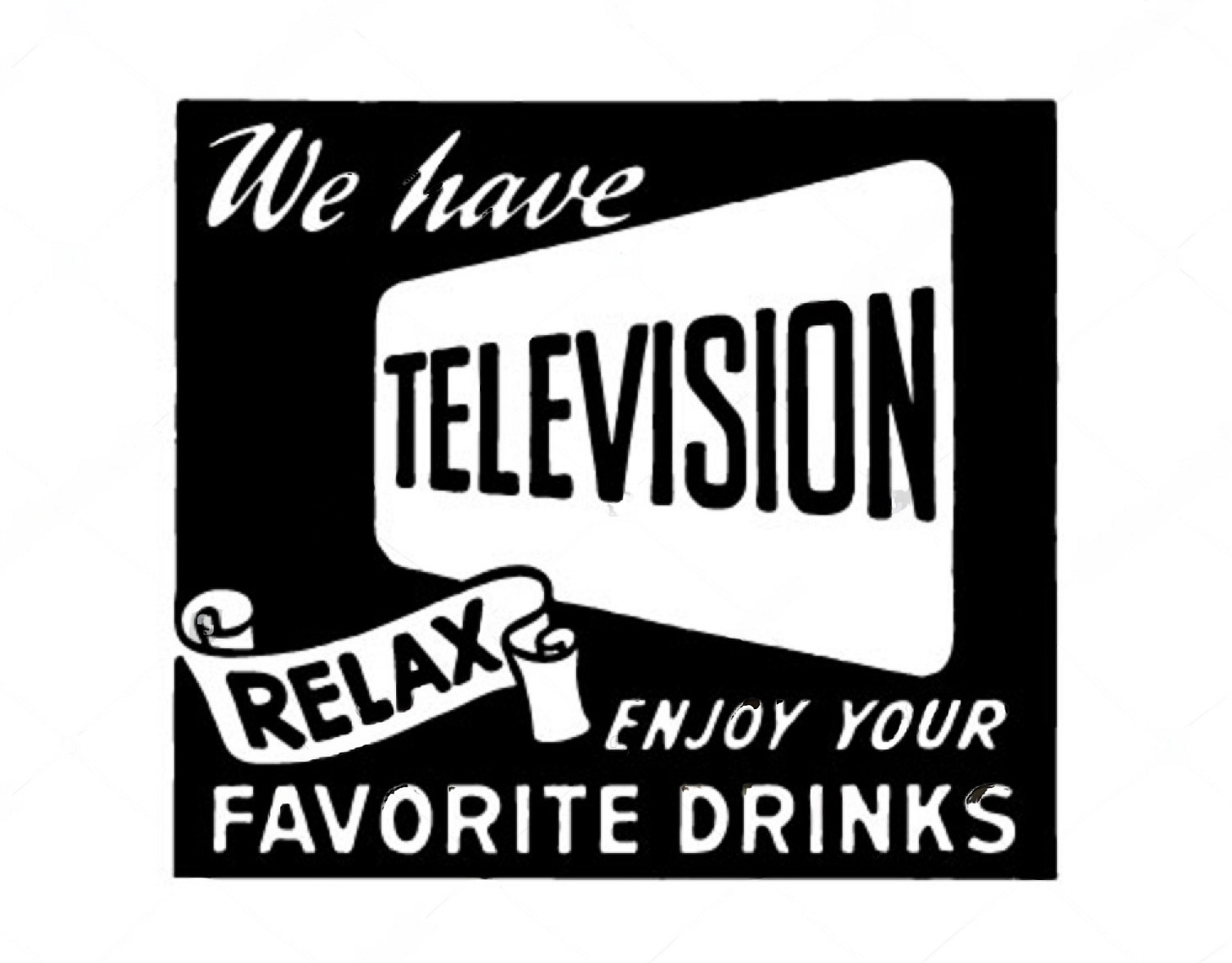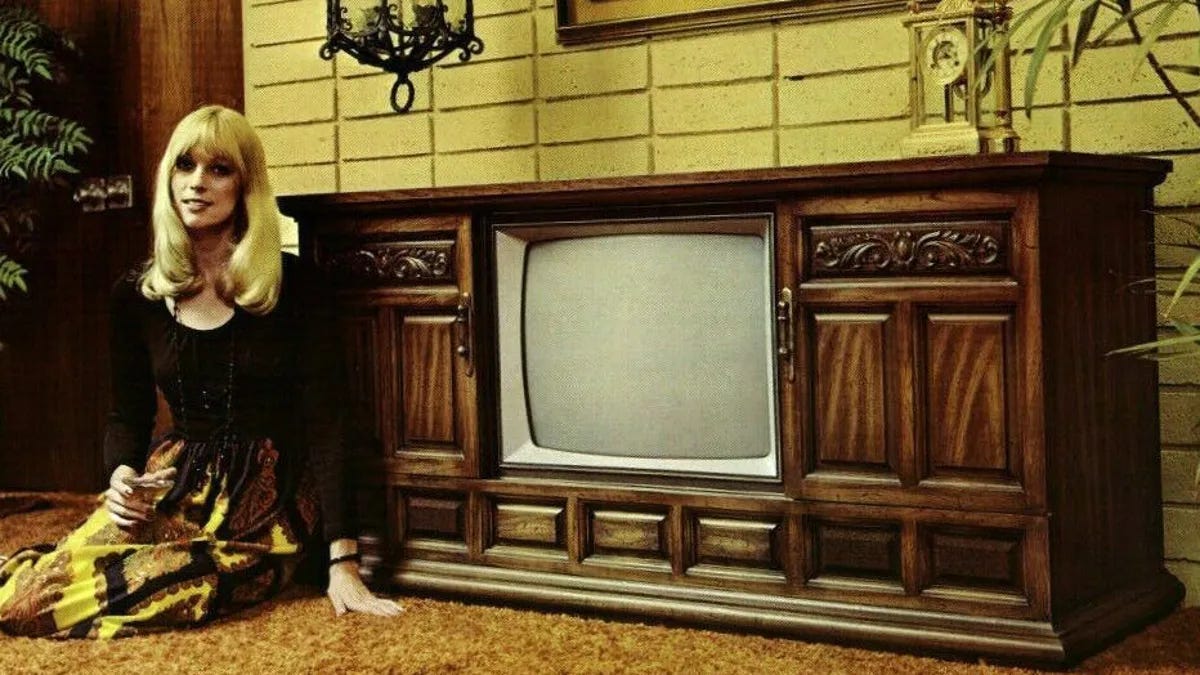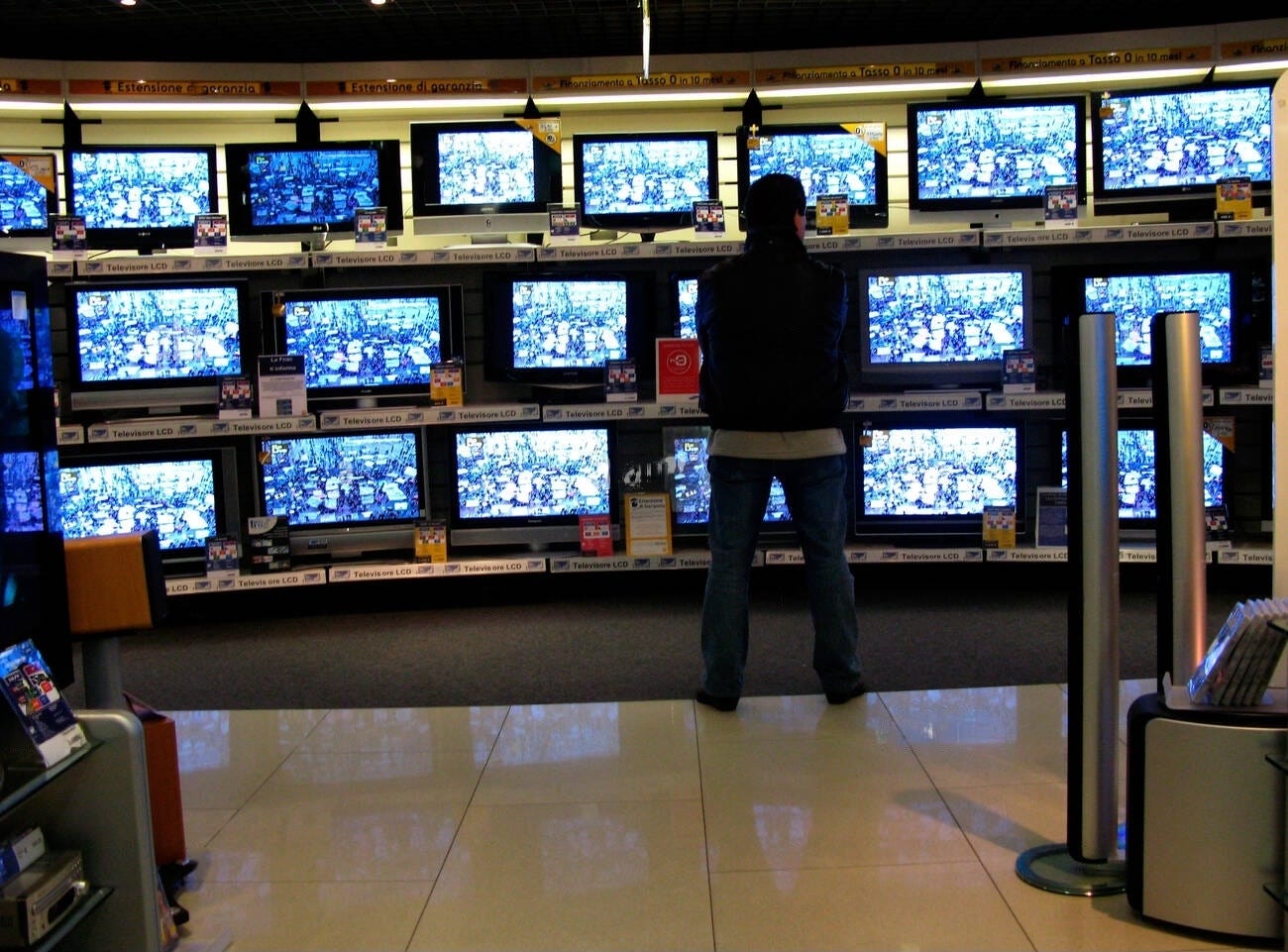Note to The Vestibule’s subscribers: This article first appeared, on 11 December 2018, in Washington University in St. Louis’s The Common Reader: A Journal of the Essay. This terrific publication, edited by Dr. Gerald Early and Ben Fulton, provided the most-regular outlet for my writing (thanks to Gerald’s and Ben’s generosity more than any talents I might possess) prior to The Vestibule’s 20 December 2021 founding.
Indeed, this piece was my first official contribution to TCR, having developed from my desire to make a learned statement (or even the beginnings of a manifesto) about how the arrival of digital platforms and streaming services had not merely changed, but in some ways radically shifted, how we received, watched, and enjoyed television.
Although stereotype might suggest that the doctorate (or Ph.D.) in English & American literature that Wash U bestowed upon me in December 2004 demands that I regard television as the embarrassing younger cousin of older, more respectable, and more sophisticated cultural forms (especially literature), I’ve never subscribed to this prejudice, not for one moment of my graduate-school career (or, for that matter, my pre- or post-graduate life).
Perhaps, as a child of the American 1970s and 1980s who watched television and film as frequently as I read books—and I was always reading one book, if not two or three, throughout my childhood and teenage years—I was predisposed to see television as just one more voice in the cultural chorus that surrounds us every moment of every day, whether or not we actively (or even consciously) listen to it.
Every so often, we working writers receive messages from people who’ve read our scribblings and wish to offer comments (sometimes praiseworthy, sometimes less so, but, at least in my case, always welcome). I recently had the pleasure of reading an email message from a master’s student in the University of Antwerp’s (yes, in Belgium) Theatre and Film Studies Programme lauding the following article as the best source she’d read about streaming television, one that, she claimed, works well for both scholarly and lay audiences (meaning that it’s not overloaded with jargon that only four or five people care to read, much less understand).
Not having encountered this piece since its publication, I gritted my teeth (as I always do when I revisit my own work). Despite expecting the worst, I was happily surprised to discover that this article, which Gerald Early cheekily titled “How Our New Electronic Dog Still Does Old Tricks,” provides relevant commentary about how American television has adapted to the Streaming Era (a term that I hereby coin).
Considering how every extant streaming service began retrenching in mid- to late-2022 by furiously cutting costs, cancelling programs, and firing staff members in a mad dash to become profitable (Netflix, for instance, claimed—or at least implied—in its third-quarter 2022 “Letter to Shareholders” that it was the only profitable streaming service), my little essay still offers—or, more humbly, seems to offer—worthwhile thoughts about where we and TV are right now (even if more than five years have passed since this article first appeared in TCM).
So, here it is again.
Or, if you’re reading this piece for the first time, here it is.
I’ve reverted to my original title, updated a few references (while retaining all the originals), and aligned this piece with The Vestibule’s house style. “Stream On” also marks The Vestibule’s 50th post, a marker I wasn’t certain I’d reach when beginning this publication in late 2021, so I thank you, dear reader, for your loyalty, your support, and your good cheer.
As the Long, Hot Summer of 2024 (and another election year!) begins, please stay cool and enjoy life as much as you can.
—All the best, Jason
1. The Shock of the New (& the Old-New)
Charles McGrath, in his now-famous (or -infamous) 1995 essay “The Triumph of the Prime-Time Novel,” advises readers to look closely at small-screen drama because, in a statement so unexpected that it took many of McGrath’s readers by surprise, “TV is actually enjoying a sort of golden age—it has become a medium you can consistently rely on not just for distraction but for enlightenment.”1
McGrath, chief editor of the New York Times Book Review when this piece first appeared in the New York Times Magazine’s 22 October 1995 issue, doesn’t make this claim sarcastically—as the snarky prelude to demolishing primetime’s overhyped narrative sophistication—or caustically, as a way to reinforce snobbish banalities about television’s pervasive influence, but instead bestows legitimacy upon the 20th Century’s most derided mass medium.
This electronic appliance, since its introduction into American homes during the 1940s and 1950s, has been hated and feared—in roughly equal measure—by literary critics, cultural gatekeepers, broadcast regulators, and viewers themselves, who (no matter their anxieties about television’s deleterious effects) always keep watching. McGrath acknowledges this hypocrisy by objecting to television’s lowbrow reputation, even going so far as to call primetime drama “one of the few remaining art forms to continue the tradition of classic American realism, the realism of Dreiser and Hopper: the painstaking, almost literal examination of middle- and working-class lives in the conviction that truth resides less in ideas than in details closely observed. More than many novels, TV tells us how we live today.”2
Three decades later, McGrath’s perspective seems prescient, if not vindicated, by the many articles, commentaries, and blog postings devoted to television’s new Golden Age. For proof, consider the surfeit of scripted series whose sheer number exhausts even avid viewers, who, listlessly scrolling through their Apple TV+, Disney+, Hulu, Max (formerly HBO Max), Netflix, Paramount+, Peacock, and Prime Video queues (to name only eight), sneer at those poor slobs clinging to their cable subscriptions. Yet even these folk must contend with hours upon hours of broadcast-, basic-, and premium-channel television saturating their digital-video recorders, a struggle that supposedly unites us all in a compensatory cultural ritual: damning the embarrassment of riches that TV (“television” only for the pretentious) now offers.
Enlightenment, realism, classic American art: McGrath offers a heady brew when conferring artistic authenticity upon television (or, at least, upon the three then-popular primetime dramas his article highlights: Steven Bochco’s and David Milch’s NYPD Blue, Michael Crichton’s ER, and Dick Wolf’s Law & Order). McGrath doesn’t get everything right, of course, since no person—no matter how smart or gifted (McGrath is both)—can predict the future, least of all a literary man discussing television’s complexities without citing a shred of scholarship about this capacious medium’s operations, parameters, and complications.
McGrath also preserves his high-culture bona fides by refusing to put good television on par with good novels: “TV will never be better than reading, thank goodness. It’s hard to imagine a tube, however small, that could approximate the convenience and portability—the companionability—of a book. And images and spoken words, no matter how eloquent, lack the suggestiveness, the invitation to something deeper, of words on a page.”3
McGrath’s final statement is a matter of opinion, even conjecture, that says more about his literary proclivities (and prejudices) than about television, while his initial observations seem dead wrong in an era where we all—family, friends, and colleagues—appear surgically attached to our smartphones. For large swathes of the American public (or for what we now, clinically and regrettably, call “users”), the tablet, e-reader, and smartphone screens that seemingly control our lives have indeed achieved the companionability that McGrath reserves for print novels.
Convenience and portability, as the digital era wends its way forward, aren’t as indigenous to paper as McGrath believed in 1995. No matter how frequently defenders of “old media” mourn the print era’s putative decline and fall, digital delivery—certainly for its most strident admirers—becomes more companionable, more commercialized, and more affordable with every passing month.
2. Out with the New. . .
And so it goes with television.
Primetime dramas first became digitally available in the late 1990s, thanks to then-new DVD (digital-video-disc) technology. I still recall my joy when receiving, in 1999 and 2000, the first-season sets of Rod Serling’s original The Twilight Zone (1959-1964), Gene Roddenberry’s Star Trek: The Next Generation (1987-1994), and Chris Carter’s The X-Files (1993-2002, 2016, 2018). These discs’ compactness, convenience, and portability allowed passionate viewers like myself the chance to revisit each episode whenever we wished. Even better, their visual clarity (amazing at the time) allowed audiences to see just how carefully each program’s production team had put these series together.
DVDs, of course, also made videotapes (and the clunky machines that played them) instant relics of a bygone era. And for literary-minded folk who saw no contradiction in loving television when not reading Proust, these box sets resembled thick novels that could comfortably sit next to Ulysses and Moby-Dick on our bookshelves. This arrangement, much like McGrath’s article, ennobles television not merely as a significant but also as a valuable mode of artistic expression.
These harbingers of the digital future, however, couldn’t predict the arrival of streaming video. People eager to forget the Great Recession may try to block out as much of 2006 to 2009 as possible, but this four-year span also lays claim to the birth of digital-video-streaming services as we now know them. Hulu, iTunes, Netflix, Prime Video, and YouTube all debuted platforms able to play movies and television episodes on desktop computers, then expanded these capabilities to WiFi-enabled devices. These services, in development for years (and, in the case of iTunes Video, for decades), became a clarion call for television’s digital rebirth.
Nature abhors a vacuum, we’re told, and so does international commerce. Once viewers realized that they could stream video over their home computers, they clamored for the same capability on their digital devices, and it didn’t take long for every manufacturer of disc players, video-game consoles, smartphones, laptops, and television sets to oblige.
As long as one paid for decent Internet connectivity and personal WiFi services, the digital frontier no longer existed on the horizon, but, instead, wherever one desired: in the waiting room, the living room, the bedroom, and even the bathroom.
Some consumers, myself included, can’t imagine returning to the days before streaming video due to the convenience, portability, and companionability that McGrath reserved for books all those years ago. Never has it been easier to watch television anywhere a good WiFi connection exists, as a 2016 trip to the DMV taught me. After using my smartphone to download an episode of Bruce Geller’s original Mission: Impossible (1966-1973) television series, the people in line behind me strained to see the screen once they heard Lalo Schifrin’s incomparable theme music issue from my phone’s speakers.
This, I realized, is the future that prognosticators Alvin Toffler and Marshall McLuhan—along with the original Star Trek (1966-1969) series and Hanna-Barbera’s animated The Jetsons (1962-1963)—predicted fifty and sixty years ago. Portable TV, for anyone paying attention, arrived well ahead of schedule (the jetpacks and flying cars, unfortunately, will take a bit longer).
All’s well, we might say, and what marvelous ends this new television landscape has wrought. Barely a week passes without articles commending the aesthetic fineness, cultural significance, and moral seriousness displayed by Hulu’s, Netflix’s, and Prime Video’s best television series. Indeed, Beau Willimon’s House of Cards (2013-2018); Jenji Kohan’s Orange Is the New Black (2013-2019); Jill Soloway’s Transparent (2014-2019); Bruce Miller’s winsome adaptation of Margaret Atwood’s The Handmaid’s Tale (2017-Present); and Brendan Hunt’s, Joe Kelly’s, Bill Lawrence’s, & Jason Sudeikis’s Ted Lasso (2020-2023) garnered so much praise that their laurels make the hagiography surrounding cable- and premium-channel stalwarts like David Chase’s The Sopranos (1999-2007), Shawn Ryan’s The Shield (2002-2008), David Simon’s The Wire (2002-2008), and Vince Gilligan’s Breaking Bad (2008-2013) seem minimalist by comparison.
The Wire is so frequently pronounced the best television series ever produced (with Breaking Bad and its sequel/prequel, Better Call Saul [2015-2022], alongside Matthew Weiner’s Mad Men [2007-2015], competing for the title) that observers making this earnest-yet-absurd claim cannot seem to remember any era before 1999, when The Sopranos first appeared on HBO (known, in those halcyon days, as Home Box Office). To hear people like Brett Martin (in his 2013 book Difficult Men: Behind the Scenes of a Creative Revolution) and David Bianculli (on NPR’s Fresh Air and his website TV Worth Watching) tell it, television has entered a New Golden Age (or what Bianculli calls TV’s New Platinum Age), that will, thanks to digital delivery, remain with us for a good, long while.
Rejoice, we are told: Television has never been better.
David Carr, the New York Times’s late media columnist, acknowledged this truth in “Barely Keeping Up in TV’s New Golden Age,” a sly 9 March 2014 essay that perfectly bookends McGrath’s “Triumph of the Prime-Time Novel.” Carr, in a resonant passage, comments, “The vast wasteland of television has been replaced by an excess of excellence that is fundamentally altering my media diet and threatening to consume my waking life in the process.”4
Carr quotes Kathleen McCaffrey, HBO’s director of original programming, as saying, at 2014’s South by Southwest Festival, that television grew up as an art form when it jettisoned medical and legal procedurals to tell stories about authentic, flawed people. “So much of the conversation,” McCaffrey claims, “comes from strong serialized dramas about people’s lives and how they live them.”5
These remarks sound as if McCaffrey so internalized McGrath’s pronouncements about primetime drama’s sophistication that she forgot how many medical, legal, and police procedurals litter America’s nightly telescape, especially the five major networks (ABC, CBS, the CW, Fox, and NBC, for those still counting). McCaffrey expresses the now-common belief that television has matured to the point where stylish storytelling and serialized drama replace the bad old days of run-and-gun, one-and-done, episodic entertainment.
Carr and McCaffrey, however, ignore New Television’s debt to the oldest, most popular, and most vilified mass-media genre of all: soap opera. So do most other commentators offering rapturous praise about television’s New Golden Age, or what John Landgraf (president of the FX networks) calls “Peak TV.”
Serialized stories, long-running character arcs, narrative density, and emotional complications are so common in televised soap operas (and their radio forebears) that viewers have forgotten, if they ever knew, just how pervasive soap-opera storytelling is. The popularity of telenovelas outside the United States testifies to the attractions of serialized drama, while the name itself (telenovela) reminds thoughtful viewers that mixing novel writing with television narrative predates David Simon’s declaration that The Wire was a “visual novel.”6
This myopic statement, made by Simon in press interviews before and after The Wire’s 2002 premiere, overlooks how Steven Bochco’s, Charles H. Eglee’s, and Channing Gibson’s excellent Murder One titled its episodes “Chapter One,” “Chapter Two,” and so forth during its inaugural (and fully serialized) 1995-1996 season while ignoring creator J. Michael Straczynski’s tireless (and tiresome) habit of calling Babylon 5 a “novel for television” during its 1994-1999 run.
Bochco’s and Michael Kozoll’s groundbreaking Hill Street Blues (1981-1987) lifted serialized storytelling wholesale from soap operas to reinvent the cop show in ways that still influence the genre, while John Wilder’s Spenser: For Hire (1985-1988, based on Robert B. Parker’s novels) and Steven J. Cannell’s & Frank Lupo’s Wiseguy (1987-1990) offered extended story arcs long before Jimmy McNulty patrolled Baltimore’s mean streets or Tony Soprano frequented New Jersey’s mob haunts.
This lineage also includes primetime soap operas Dallas (1978-1991 and 2012-2014), Knots Landing (1979-1993), Dynasty (1981-1989 and 2017-2022), Falcon Crest (1981-1990), The Colbys (1985-1987), and Desperate Housewives (2004-2012), to say nothing of Shonda Rhimes’s contributions to the form: Grey’s Anatomy (2005-Present) and the gloriously unhinged Scandal (2012-2018). And Peyton Place (1964-1969) was telling intricately connected primetime stories before them all, proving that, for nearly every innovation extolled by New Television’s current admirers, earlier television got there first.
3. In with the Old. . .
This cultural amnesia is unsurprising. Unshackling television from the large console appliance that once occupied so many American living rooms—truly, television as furniture—has freed viewing habits in ways that only crewmembers of the Starship Enterprise once enjoyed. The prevalence of cord cutting—people surrendering their one-size-fits-all cable subscriptions for à-la-carte streaming services—and the production of new series by digital platforms have fomented an apparent revolution that shows no signs of stopping.
And this new era is revolutionary in one crucial way: We now have so many choices about what, where, and when to watch television that, like David Carr, we can easily feel overwhelmed. The future has arrived, meaning that observers like myself, who for years have argued that television is not the bastard stepchild of older cultural forms, can retire, happy and healthy and secure in the knowledge that we have won the fight. Television is now taken as seriously as any other art form, indeed so seriously that, like Carr, we now feel guilty for losing pace with the medium, in the same way that jejune lists of “The Greatest Novels Ever Written” force literature professors like myself to hang our heads in shame for not having read every single one.
Amanda D. Lotz, in her invaluable book The Television Will Be Revolutionized, pinpoints the strange moment we find ourselves occupying. “With such ample variation in the availability and ubiquity of television programming,” Lotz writes, “we need more specific models for understanding television’s operation in the culture, ones that will enable us to differentially assess its significance.”7 She proposes the term phenomenal television “as a particular category of programming that retains the social importance attributed to television’s earlier operation as a cultural forum despite the changes of the post-network era,”8 with the post-network era taking shape in the mid-2000s, after the traditional networks’ dominance began to wane.
American television programming, Lotz notes, quickly multiplied as basic-cable and premium channels began producing their own series. Digital streaming has only upped this ante, and one of Lotz’s signature contributions in The Television Will Be Revolutionized is to anticipate so capably the effects that these digital platforms will have (and have had) on our viewing habits despite not knowing, upon the 2007 publication of her book’s first edition, exactly how they would transform the medium.
Yet, as Lotz comments at various points during her study, this transformation still returns television storytelling to its roots in radio, a point that Jason Mittell expertly acknowledges in Genre and Television: From Cop Shows to Cartoons in American Culture when discussing the significance of soap operas to both radio and television: “The soap opera has a lengthy history dating back to 1930s radio, but most relevantly in the late 1960s and 1970s, soap operas began to shift their focus toward emphasizing social issues like race relations, abortion, and women’s health, as well as turning toward more bold depictions of sexuality.”9
With slight variations, this statement applies to the “phenomenal television” series that we now regularly dissect, praise, and venerate. The serialization, character arcs, and narrative density of House of Cards, Orange Is the New Black, Transparent, and Ted Lasso—qualities that seem so fresh, so new, and so liberating for streaming platforms—are, indeed, the same traits that The Guiding Light employed from its 1937 radio debut to its 2009 televised conclusion, that Days of Our Lives has used since its 1965 television premiere, and that Coronation Street—one of the world’s longest-running television programs—has plied since its first episode aired on Britain’s ITV Network on 9 December 1960.
These narrative strategies may appear more respectable when scholars, critics, and reviewers discuss their use in cable-, premium-, and digital-television series, but, make no mistake, they remain closer to their soap-opera beginnings than we may care to think. Charles McGrath is correct to note that the prime-time novel can be as bracing, intelligent, and valuable an artistic contribution to American culture as the novel itself, but this truth shouldn’t occlude the long, winding, and complicated lineage that has brought us to the point where we watch phenomenal television, good television, mediocre television, and bad television wherever (and whenever) we want.
Leave it to Russell T. Davies—creator of Queer as Folk (1999-2000), Bob & Rose (2001), The Second Coming (2003), Torchwood (2006-2011), Banana (2015), Cucumber (2015), Tofu (2015), Years and Years (2019), It’s a Sin (2021), and Nolly (2023), and the man who regenerated Doctor Who in 2005—to offer the most thoughtful insights about our new viewing era. During his 13 April 2015 conversation with Slate’s June Thomas, Davies makes these observations:
It’s a fascinating time in television. The monoliths established by the white, straight male are crumbling, because we’re getting bored of those stories. We’re realizing the world is richer. I think TV in particular is responsible for reminding us that the world is not just composed of people exactly like ourselves and that everyone’s got a story to tell.10
Davies, one of his generation’s best television writers and producers, understands how these changes connect the brave new world of digital television to earlier narrative forms, saying that his programs do not “shy away from the grime” because “all television writing in Britain is founded upon the success of the primetime soap opera, and British soap operas are very different from American ones: They’re very much based in reality, and they come from a working-class tradition.”11
If Davies seems to parrot McGrath’s 1995 praise for the primetime novel’s concerns with realism, with working-class lives, and with taking people as they are, fret not: Davies also loves TV shows that depict people as they imagine themselves to be (meaning intelligent, attractive, and sexually irresistible).
Davies, in his excitable way, reminds us how all that is old becomes new again. We have traveled far in terms of television’s delivery, portability, and companionability, but return home to find its preference for long, dense, serialized stories making fewer concessions to the network era’s lowest-common-denominator programming by updating soap-opera conventions at every turn. Television’s artistic reputation has never been higher, but this development, long sought by its proponents, returns us to the medium’s origins.
So, all hail New Television!
It is not so different from the old.
FILES
NOTES
Charles McGrath, “The Triumph of the Prime-Time Novel,” New York Times Magazine, 22 October 1995, 52, https://www.dropbox.com/scl/fi/g8k8r8n12y2xq9x81ihet/mcgrath_triumph-of-prime-time-novel_nyt_10-22-95.pdf rlkey=0wm0e3omq5ywir4ks3vsot7b0&st=qkgv4ley&dl=0
Readers who prefer to read McGrath’s article online may find it at http://www.nytimes.com/1995/10/22/magazine/the-prime-time-novel-the-triumph-of-the-prime-time-novel.html?pagewanted=all.
McGrath’s essay also appears in Horace Newcomb’s Television: The Critical View, Sixth Edition, Oxford UP, 2000, pp. 242-252.
Ibid., 53.
Ibid.
David Carr, “Barely Keeping Up in TV’s New Golden Age,” New York Times, 9 March 2014, http://www.nytimes.com/2014/03/10/business/media/fenced-in-by-televisions-excess-of-excellence.html?_r=0.
Ibid.
David Simon, introduction to “The Wire”: Truth Be Told by Rafael Alvarez, Pocket Books, 2004, 25.
In this book’s second edition (published by Grove Press in 2010), Simon refers to The Wire as a visual novel on Page 24.
Amanda D. Lotz, The Television Will Be Revolutionized, New York University Press, 2007, 37.
In this book’s second edition (published by New York University Press in 2014), Lotz defines phenomenal television on Page 42.
Ibid.
Jason Mittell, Genre and Television: From Cop Shows to Cartoons in American Culture, New York: Routledge, 2004, 163.
June Thomas, “Russell T. Davies on Sex, Intergenerational Relationships, and Telling New Gay Stories,” Slate, 13 April 2015, http://www.slate.com/blogs/outward/2015/04/13/russell_t_davies_interview_doctor_who_queer_as_folk_cucumber_and_banana.html.
Ibid.




